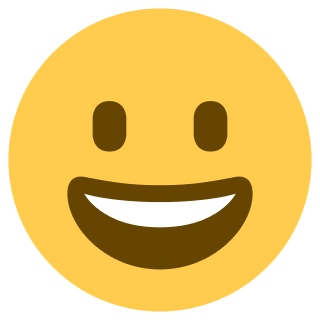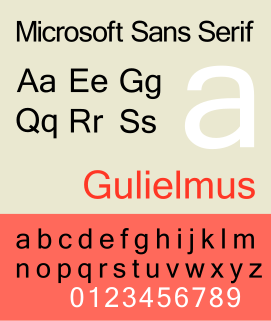
In typography, a dingbat is an ornament, a glyph used in typesetting, often employed to create box frames or as a dinkus. Some of the dingbat symbols have been used as signature marks, used in bookbinding to order sections.

An emoji is a pictogram, logogram, ideogram or smiley embedded in text and used in electronic messages and web pages. The primary function of emoji is to fill in emotional cues otherwise missing from typed conversation. Some examples of emoji are 😂, 😃, 🧘🏻♂️, 🌍, 🍞, 🚗, 📞, 🎉, ❤️, 🍆, and 🏁. Emoji exist in various genres, including facial expressions, common objects, places and types of weather, and animals. They are much like emoticons, but emoji are pictures rather than typographic approximations; the term "emoji" in the strict sense refers to such pictures which can be represented as encoded characters, but it is sometimes applied to messaging stickers by extension. Originally meaning pictograph, the word emoji comes from Japanese e + moji; the resemblance to the English words emotion and emoticon is purely coincidental. The ISO 15924 script code for emoji is Zsye.
In Unicode, a Private Use Area (PUA) is a range of code points that, by definition, will not be assigned characters by the Unicode Consortium. Three private use areas are defined: one in the Basic Multilingual Plane, and one each in, and nearly covering, planes 15 and 16. The code points in these areas cannot be considered as standardized characters in Unicode itself. They are intentionally left undefined so that third parties may define their own characters without conflicting with Unicode Consortium assignments. Under the Unicode Stability Policy, the Private Use Areas will remain allocated for that purpose in all future Unicode versions.

Monospace is a monospaced Unicode font, developed by George Williams. It is based on the typeface Courier. This font contains 2860 glyphs. It includes characters in the following unicode ranges: Basic Latin, Latin-1 Supplement, Latin Extended-A, Latin Extended-B, IPA Extensions, Spacing Modifier Letters, Combining Diacritical Marks, Greek, Cyrillic, Hebrew, Latin Extended Additional, Greek Extended, General Punctuation, Superscripts and Subscripts, Currency Symbols, Combining Diacritical Marks for Symbols, Letterlike Symbols, Number Forms, Arrows, Mathematical Operators, Miscellaneous Technical, Control Pictures, Enclosed Alphanumerics, Box Drawing, Block Elements, Geometric Shapes, Miscellaneous Symbols, Alphabetic Presentation Forms, Halfwidth and Fullwidth Forms.
Geometric Shapes is a Unicode block of 96 symbols at code point range U+25A0–25FF.
New Gulim (새굴림/SaeGulRim) is a sans-serif type Unicode font designed especially for the Korean-language script, designed by HanYang System Co., Limited. It is an expanded version of Hanyang Gulrim.
Symbol is one of the four standard fonts available on all PostScript-based printers, starting with Apple's original LaserWriter (1985). It contains a complete unaccented Greek alphabet and a selection of commonly used mathematical symbols. Insofar as it fits into any standard classification, it is a serif font designed in the style of Times New Roman.
Unicode supports several phonetic scripts and notations through the existing writing systems and the addition of extra blocks with phonetic characters. These phonetic extras are derived of an existing script, usually Latin, Greek or Cyrillic. In Unicode there is no "IPA script". Apart from IPA, extensions to the IPA and obsolete and nonstandard IPA symbols, these blocks also contain characters from the Uralic Phonetic Alphabet and the Americanist Phonetic Alphabet.
In computing, a Unicode symbol is a Unicode character which is not part of a script used to write a natural language, but is nonetheless available for use as part of a text.

The Unicode Standard encodes almost all standard characters used in mathematics. Unicode Technical Report #25 provides comprehensive information about the character repertoire, their properties, and guidelines for implementation. Mathematical operators and symbols are in multiple Unicode blocks. Some of these blocks are dedicated to, or primarily contain, mathematical characters while others are a mix of mathematical and non-mathematical characters. This article covers all Unicode characters with a derived property of "Math".

Microsoft Sans Serif is a TrueType font introduced with early Windows versions. It is a successor of MS Sans Serif, a proportional raster font introduced in Windows 1.0. Both fonts are very similar in design to Arial and Helvetica. This font was made to match the MS Sans bitmap included in the early releases of Microsoft Windows.

The Unicode Consortium (UC) and the International Organisation for Standardisation (ISO) collaborate on the Universal Character Set (UCS). The UCS is an international standard to map characters used in natural language, mathematics, music, and other domains to machine-readable values. By creating this mapping, the UCS enables computer software vendors to interoperate and transmit UCS-encoded text strings from one to another. Because it is a universal map, it can be used to represent multiple languages at the same time. This avoids the confusion of using multiple legacy character encodings, which can result in the same sequence of codes having multiple meanings and thus be improperly decoded if the wrong one is chosen.
In the Unicode standard, a plane is a continuous group of 65,536 (216) code points. There are 17 planes, identified by the numbers 0 to 16, which corresponds with the possible values 00–1016 of the first two positions in six position hexadecimal format (U+hhhhhh). Plane 0 is the Basic Multilingual Plane (BMP), which contains most commonly used characters. The higher planes 1 through 16 are called "supplementary planes". The last code point in Unicode is the last code point in plane 16, U+10FFFF. As of Unicode version 13.0, seven of the planes have assigned code points (characters), and five are named.
Miscellaneous Symbols and Pictographs is a Unicode block containing meteorological and astronomical symbols, emoji characters largely for compatibility with Japanese telephone carriers' implementations of Shift JIS, and characters originally from the Wingdings and Webdings fonts found in Microsoft Windows.
A variant form is a different glyph for a character, encoded in Unicode through the mechanism of variation sequences: sequences in Unicode that consist of a base character followed by a variation selector character.
Emoticons is a Unicode block containing emoticons or emoji. Most of them are intended as representations of faces, although some of them include hand gestures or non-human characters.
Euphemia is a sans-serif typeface for Unified Canadian Syllabics. However, it does not display the Eastern Cree syllables sha and shu properly.
Variation Selectors is the block name of a Unicode code point block containing 16 variation selectors. Each variation selector is used to specify a specific glyph variant for a preceding character. They are currently used to specify standardized variation sequences for mathematical symbols, emoji symbols, 'Phags-pa letters, and CJK unified ideographs corresponding to CJK compatibility ideographs. At present only standardized variation sequences with VS1, VS2, VS3, VS15 and VS16 have been defined; VS15 and VS16 are reserved to request that a character should be displayed as text or as an emoji respectively.
Quivira is a serif Unicode typeface by Alexander Lange.
A number of Greek letters, variants, digits, and other symbols are supported by the Unicode character encoding standard.





